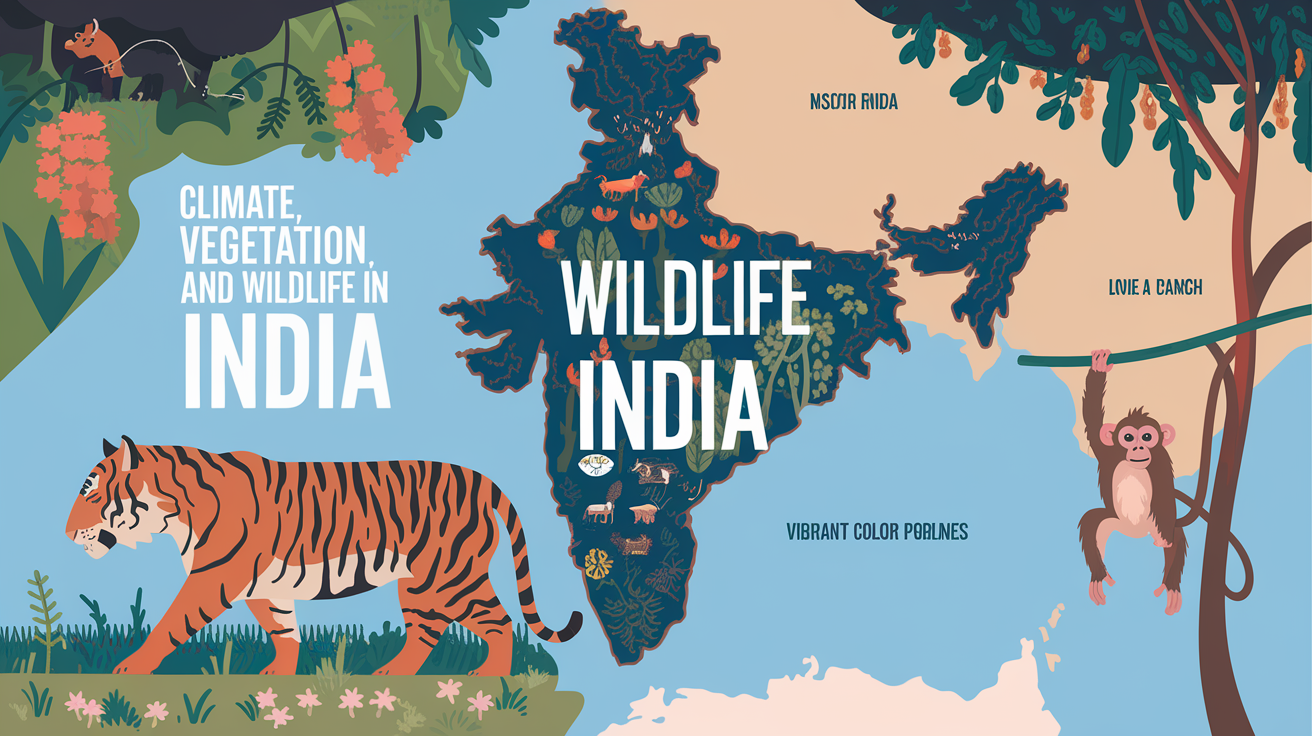
Chapter 8: India- Climate, Vegetation and Wildlife
NCERT Solutions for Class 6th Social Science GEOGRAPHY–
India – Climate, Vegetation and Wildlife

The Climate of India
India has diverse climatic conditions. The two terms, climate and weather, largely differ from each other.
| Weather | Climate |
| It deals with the changes in the atmosphere over a short period of time. | It deals with the changes in the atmosphere over a longer period of time, i.e., over thirty to forty years. |
| The weather of a place may change daily. | The climate of a place remains constant for a long period of time. |
The climate of India can be divided into the following four major weather seasons:
- Cold Weather Season: Winter in India begins in December and lasts till February. Since the Sun’s rays do not fall directly over the region, the temperatures become low, especially in North India.
- Hot Weather Season: This season begins in March and lasts till May. During this season, the Sun shines directly overhead. This leads to a rise in temperature. In northern India, local hot and dry local winds blow which are known as ‘loo’. People during this season drink ‘sharbat’ and consume fruits with a high water content like litchi, watermelon etc.
- South-West Monsoon Season: The Monsoon winds which blow from the Arabian Sea and the Bay of Bengal are laden with moisture. These winds strike the mountains bringing
rainfall into the country. The monsoon season in India lasts for four months i.e., from June to September.
- Season of Retreating Monsoon: The season from October to mid-November is known as the season of retreating monsoons. Also known as autumn, the monsoon winds in India begin to retreat. The states of Tamil Nadu and Andhra Pradesh receive rainfall during this time.
The climate of India is broadly described as the monsoon type. This type of climate ensures ample rainfall to the country which is vital for the flourishing agriculture in the country. The climate of a place is affected by its location, altitude, distance from the sea and various physical or relief features. This is the reason why the desert regions of Jaisalmer and Bikaner are extremely hot, while the Drass and Kargil regions in Jammu and Kashmir experience extremely cold conditions. Coastal regions such as Mumbai and Kolkata experience a moderate climate. Mawsynram in Meghalaya receives the highest rainfall in the world.
Natural Vegetation
The trees, grasses and shrubs which grow on their own without any human interference are called natural vegetation. The growth of natural vegetation depends on various climatic conditions. Since India has varied climatic conditions, we find a rich variety of natural vegetation in the country. Following are the five types of natural vegetation in India:
Tropical Rain Forests
-
- These occur in the areas of heavy rainfall. Tropical rain forests are so dense that even sunlight is not able to reach the ground.
- These forests are also known as evergreen forests as all the trees do not shed their leaves at the same time and hence they always appear green.
- They are found in North Eastern India, Andaman and Nicobar Islands and a part of Western slopes of the Western Ghats.
- Important trees in these forests are ebony, mahogany and rosewood.
Tropical Deciduous Forests
- Also known as the monsoon forests, tropical deciduous forests are less dense and are found over large parts of the country.
- The trees in these forests shed their leaves at a particular time in a year.
- These forests are found in Uttar Pradesh, Bihar, Madhya Pradesh, Jharkhand, Chhattisgarh, Odisha and in some parts of Maharashtra.
- Teak, sal, neem, shisham and sal are some important species of trees found in the tropical deciduous forests.
Thorny Bushes
- This kind of vegetation is found in the hot and dry regions of the country.
- The leaves have spines in order to prevent the loss of water. They are found in the states of Rajasthan, Haryana, Gujarat and the eastern slopes of the Western Ghats.
- Some important varieties of trees are khair, keekar and babool.
Mountain Vegetation
- These forests are mainly found in the mountainous regions of the country.
- The species of trees differ with an increase in altitude.
- As we go up to the height of 1500-2,500 metres, the temperature reduces and thus most of the trees are conical in shape. These trees are known as coniferous trees.
- Deodar, pine and cedar are some important species of trees in these forests.
Mangrove Forests
- An important feature of these forests is that they can survive in fresh as well as saline water.
- They are found mainly in the Sunderbans in West Bengal and in the Andaman and Nicobar Islands.
- The Sunderbans have been named after the Sundari trees, which are generally found in the mangrove forests.
Importance of Forests
The Indian Wild Life
Due to diverse climatic conditions and existence of different types of forests, India is home to a great variety of wild life.
- Many reptiles, amphibians, mammals, birds, insects etc are found in the Indian forests.
- The tiger is our national animal and is found in many parts of the country.
- Asiatic lions are found in the Gir forests of Gujarat.
- Assam and Kerala are the homes of elephants and the one horned rhinoceroses are found in the forests of Assam.
- While wild goats, snow leopards and bears are found in the cold regions of the Himalayan forests, camels and wild asses are found in the desert regions of Rajasthan
and Gujarat.
-
- Monkey, wolf, deer and jackal are some common animals which are found all over the country.
- India is also the home of colourful birds such as the parrots, mynahs, bulbuls, geese, ducks etc.
- The peacock is the national bird of India.
- Many sanctuaries and forest reserves have been set up by the government to provide a natural habitat to the wild life of the country.
Important Questions
- Multiple Choice Questions:
Question 1. The trees having conical shape are called:
(a) Cactus
(b) Thorny
(c) Coniferous
Question 2. Peepal, Neem and Shisham are trees:
(a) Tropical Deciduous Forests
(b) Thorny Bushes
(c) Mangrove
Question 3. Jaisalmer and Bikaner of Rajasthan are:
(c) Hot
(b) Very Hot
(c) Moderate
Question 4. The word ‘Barish’ is the world of:
(a) Hindi
(b) Urdu
(c) Sanskrit
Question 5. Season of Retreating Monsoon is also called:
(a) Winter
(b) Rainy
(c) Autumn
Question 6. Our National animal is:
(a) Lion
(b) Tiger
(c) Elephant
Question 7. Our National Bird is:
(a) Sparrow
(b) Parrots
(c) Peacock
Question 8. Siberian Cranes arrive in India in the month of:
(a) December
(b) January
(c) February
Question 9. The roots of plans control:
(a) Underground water
(b) Fertility
(c) Soil erosion
Question 10. Plants release:
(a) Oxygen
(b) Carbon dioxide
(c) Nitrogen
Question 11. Which of the following of not the among the season of India
(a) Climate
(b) Retreating monsoon
(c) Winter
(d) Rainy
Question 12. March to May is the season of
(a) Monsoon
(b) South-west Monsoon season
(c) Hot weather Season
(d) Cold weather season
Question 13. Agriculture in India depends upon
(a) Drought
(b) Snowfall
(c) Rains
(d) Flood
Question 14. Mangrove forests can thrive in
(a) Sweet water
(b) Polluted water
(c) Fresh water
(d) Saline water
Question 15. Sunderban is located in
(a) Rajasthan
(b) West Bengal
(c) Gujarat
(d) Western Ghats
- Fill in the blanks:
- Gir forest in Gujarat is the home of _________.
- Elephants and one-horned rhinoceroses roam in the forests of _________.
- The ________ is our national bird.
- Cold Weather Season remains from __________ to _______.
- Write true (T) or false (F):
- During the south west monsoon period, the moisture laden winds blow from sea to land.
- Coastal places like Mumbai and Kolkata experience extreme climate.
- The tiger is our national animal.
- Tropical deciduous forest is found in dry areas of the country.
- Very Short Questions:
- Write one adaptation of mountain vegetation.
- What are called bushes?
- Where does the world’s highest rainfall occur?
- Where can the mangrove forest survive?
- Where wild goats and snow leopards are found?
- Which forests are also known as monsoon forests?
- What is loo?
- Where mahogany and rosewood trees are found?
- When do we like to eat or drink cold things?
- When do we wear woollen clothes?
- Short Questions:
- Name the different types of vegetation found in India.
- What are coniferous trees? Give some examples.
- What steps government has taken to conserve wildlife?
- What do you mean by season of the retreating monsoons?
- Write a note on thorny bushes.
- Name the different seasons in India.
- Long Questions:
- Why do we experience regional differences in the climate of India? Explain.
- Write about wildlife of India.
- What is the difference between evergreen forest and deciduous forest?
- Explain the different types of seasons found in India.
- Write a note on different types of vegetation found in India.
ANSWER KEY
- Multiple Choice Answer:
- (c) Coniferous
- (a) Tropical Deciduous Forests
- (b) Very Hot
- (b) Urdu
- (c) Autumn
- (b) Tiger
- (c) Peacock
- (a) December
- (c) Soil erosion
- (a) Oxygen
- (a) Climate
- (c) Hot weather Season
- (c) Rains
- (d) Saline water
- (b) West Bengal
- Fill in the blanks:
- Asiatic lions
- Assam
- Peacock
- December to February
- Write true (T) or false (F):
- True
- False
- True
- False
- Very Short Answer:
- Trees in mountain region are conical in shape.
- Small plants are called bushes.
- The world’s highest rainfall occurs in Mawsynram.
- These forests can survive in saline water.
- Wild goats and snow leopards are found in Himalayan region.
- Tropical deciduous forests are also known as monsoon forests.
- Hot and dry winds blow during the day in summer is called loo.
- Mahogany and rosewood trees are found in tropical evergreen forests.
- On hot day sunny day we like to eat or drink cold things.
- We wear woollen clothes when we feel cold.
- Short Answer:
-
- Vegetation of India can be divided into five types – Tropical evergreen forest, Tropical deciduous forest, Thorny bushes, Mountain vegetation and Mangrove forests.
- At a height between 1500 metres and 2500 metres most of the trees are conical in shape. These trees are called coniferous trees. Chir, Pine and Deodar are important trees of these forests.
- In order to protect them many national parks, sanctuaries and biosphere reserves have been set up. The Government has also started Project Tiger and Project Elephant to protect these animals.
- Winds move back from the mainland to the Bay of Bengal. This is the season of the retreating monsoons. The southern parts of India, particularly Tamil Nadu and Andhra Pradesh receive rainfall in this season.
- This type of vegetation is found in dry areas of the country. The leaves are in the form of spines to reduce the loss of water. Cactus, khair, babool, keekar are important and are found in the states of Rajasthan, Punjab, Haryana, Eastern slopes of Western Ghats and Gujarat.
- The major seasons in India are:
- Cold Weather Season (Winter) December to February.
- Hot Weather Season (Summer) March to May.
- Southwest Monsoon Season (Rainy) June to September.
- Season of Retreating Monsoon (Autumn) October and November.
- Long Answer:
-
- The climate of a place is affected by its location, altitude, distance from the sea, and relief. Therefore, we experience regional differences in the climate of India. Jaisalmer and Bikaner in the desert of Rajasthan are very hot, while Drass and Kargil in Jammu and Kashmir are freezing cold. Coastal places like Mumbai and Kolkata experience moderate climate. Mawsynram in Meghalaya receives the world’s highest rainfall, while in a particular year it might not rain at all in Jaisalmer in Rajasthan.
- Forests are home to a variety of wild life. There are thousands of species of animals and a large variety of reptiles, amphibians, mammals, birds, insects and worms which dwell in the forest. Gir forest in Gujarat is the home of Asiatic lions. Elephants and one-horned rhinoceroses roam in the forests of Assam. Elephants are also found in Kerala and Karnataka. Camels and wild asses are found in the Great Indian desert and the Rann of Kuchchh respectively. Wild goats, snow leopards, bears, etc. are found in the Himalayan region. Besides these, many other animals are found in our country such as monkey, wolf, jackal, nilgai, cheetal, etc. India is equally rich in bird life. This includes birds are parrots, pigeons, mynah, geese, bulbul and ducks.
- Difference between evergreen forest and deciduous forest:
| Evergreen forest | Deciduous forest |
| Tropical Rain Forests occur in the areas which receive heavy rainfall. | In a large part of India we have this type of forest. |
| They always appear green and are called evergreen forest | These forests are also called monsoon forests. |
| They are so dense that sunlight doesn’t reach the ground. | They are less dense. |
| They shed their leaves at different times of the year. | They shed their leaves at a particular time of the year. |
| Important trees found in these forests are mahogany, ebony and rosewood. | Important trees found in these forests are sal, teak, peepal, neem and shisham. |
| They are found in Andaman and Nicobar Islands, parts of North-Eastern states and a narrow strip of the Western slope of the Western Ghats | They are found in Madhya Pradesh, Uttar Pradesh, Bihar, Jharkhand, Chhattisgarh, Odisha, and in parts of Maharashtra. |
- The major seasons recognized in India are:
- Cold Weather Season (Winter) December to February: During the winter season, the sun rays do not fall directly in the region. As a result the temperatures are quite low in northern India.
- Hot Weather Season (Summer) March to May: In the hot weather season sun rays more or less directly fall in this region. Temperature becomes very high. Hot and dry winds called loo, blow during the day.
- Southwest Monsoon Season (Rainy) June to September: This season is marked by the onset and advance of monsoon. The winds blow from Arabian Sea and Bay of Bengal towards the land. They carry moisture with them. When these winds strike the mountain barriers, rainfall occurs.
- Season of Retreating Monsoon (Autumn) October and November: Winds move back from the mainland to the Bay of Bengal. This is the season of the retreating monsoons. The southern parts of India, particularly Tamil Nadu and Andhra Pradesh receive rainfall in this season.
- Different types of vegetation found in India:
- Tropical Rain Forests: Tropical Rain Forests occur in the areas which receive heavy rainfall. They are so dense that sunlight doesn’t reach the ground. Many species of trees are found in these forests, which shed their leaves at different times of the year. Andaman and Nicobar Islands, parts of North-Eastern states and a narrow strip of the Western slope of the Western Ghats are home of these forests.
- Tropical Deciduous Forests: In a large part of our country we have this type of forest. These forests are also called monsoon forests. They are less dense. They shed their leaves at a particular time of the year. Important trees of these forests are sal, teak, peepal, neem and shisham. They are found in Madhya Pradesh, Uttar Pradesh, Bihar, Jharkhand, Chhattisgarh, Odisha, and in parts of Maharashtra.
- Thorny Bushes: This type of vegetation is found in dry areas of the country. The leaves are in the form of spines to reduce the loss of water. Cactus, khair, babool, keekar are important and are found in the states of Rajasthan, Punjab, Haryana, Eastern slopes of Western Ghats and Gujarat.
- Mountain Vegetation: A wide range of species is found in the mountains according to the variation in height. With increase in height, the temperature falls. At a height between 1500 metres and 2500 metres most of the trees are conical in shape. These trees are called coniferous trees. Chir, Pine and Deodar are important trees of these forests.
- Mangrove Forests: These forests can survive in saline water. They are found mainly in Sunderbans in West Bengal and in the Andaman and Nicobar Islands. Sundari is a well-known species of trees in mangrove forests after which Sunderbans have been named.




